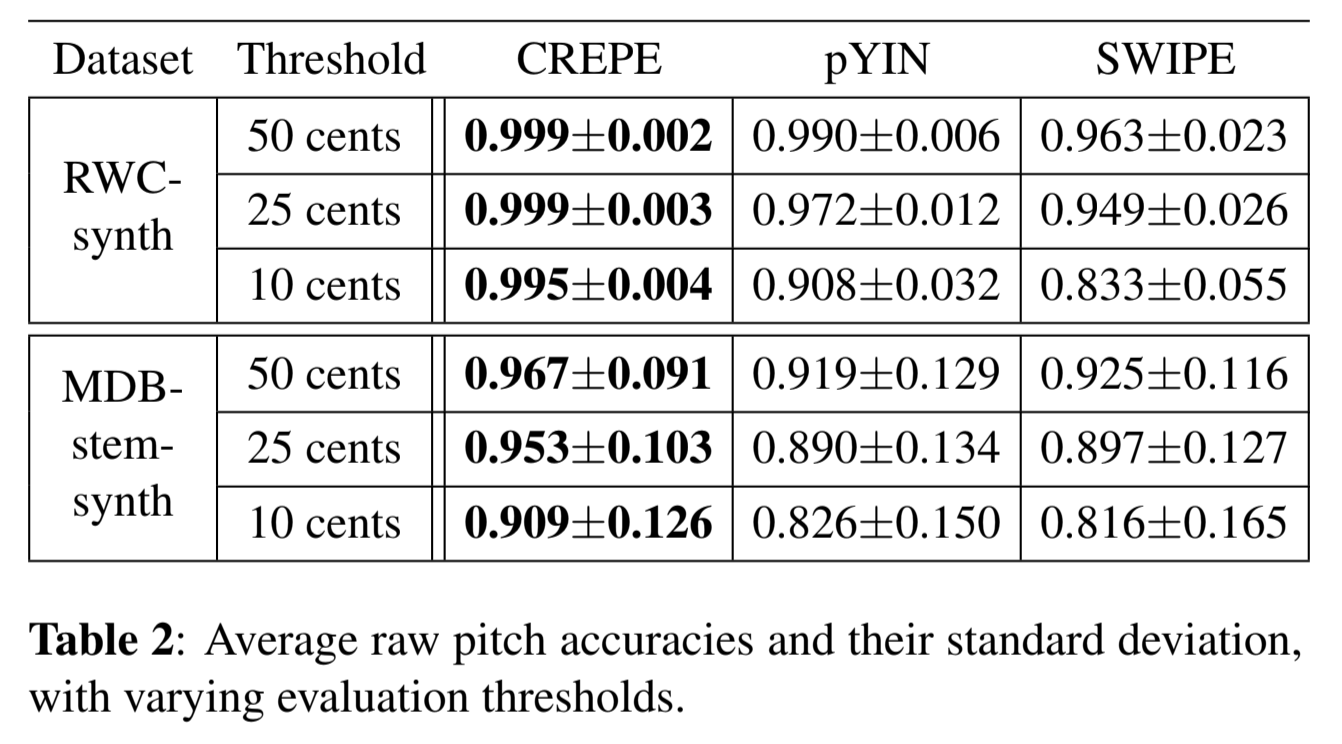CREPE pitch tracker
Project description
CREPE Pitch Tracker 
CREPE is a monophonic pitch tracker based on a deep convolutional neural network operating directly on the time-domain waveform input. CREPE is state-of-the-art (as of 2018), outperfoming popular pitch trackers such as pYIN and SWIPE:
Further details are provided in the following paper:
CREPE: A Convolutional Representation for Pitch Estimation
Jong Wook Kim, Justin Salamon, Peter Li, Juan Pablo Bello.
Proceedings of the IEEE International Conference on Acoustics, Speech, and Signal Processing (ICASSP), 2018.
We kindly request that academic publications making use of CREPE cite the aforementioned paper.
Installing CREPE
CREPE is hosted on PyPI. To install, run the following command in your Python environment:
$ pip install --upgrade tensorflow # if you don't already have tensorflow >= 1.6.0
$ pip install crepe
To install the latest version from source clone the repository and from the top-level crepe folder call:
$ python setup.py install
Using CREPE
Using CREPE from the command line
This package includes a command line utility crepe and a pre-trained version of the CREPE model for easy use. To estimate the pitch of audio_file.wav, run:
$ crepe audio_file.wav
or
$ python -m crepe audio_file.wav
The resulting audio_file.f0.csv contains 3 columns: the first with timestamps (a 10 ms hop size is used), the second contains the predicted fundamental frequency in Hz, and the third contains the voicing confidence, i.e. the confidence in the presence of a pitch:
time,frequency,confidence
0.00,185.616,0.907112
0.01,186.764,0.844488
0.02,188.356,0.798015
0.03,190.610,0.746729
0.04,192.952,0.771268
0.05,195.191,0.859440
0.06,196.541,0.864447
0.07,197.809,0.827441
0.08,199.678,0.775208
...
Timestamps
Following the convention adopted by popular audio processing libraries such as
Essentia and Librosa,
from v0.0.5 onwards CREPE will pad the input signal such that the first frame
is zero-centered (the center of the frame corresponds to time 0) and generally
all frames are centered around their corresponding timestamp, i.e. frame
D[:, t] is centered at audio[t * hop_length]. This behavior can be changed
by specifying the optional --no-centering flag, in which case the first frame
will start at time zero and generally frame D[:, t] will begin at
audio[t * hop_length]. Sticking to the default behavior (centered frames) is
strongly recommended to avoid misalignment with features and annotations produced
by other common audio processing tools.
Temporal smoothing
By default CREPE does not apply temporal smoothing to the pitch curve, but
Viterbi smoothing is supported via the optional --viterbi command line argument.
Saving the activation matrix
The script can also optionally save the output activation matrix of the model
to an npy file (--save-activation), where the matrix dimensions are
(n_frames, 360) using a hop size of 10 ms (there are 360 pitch bins covering 20
cents each).
The script can also output a plot of the activation matrix (--save-plot),
saved to audio_file.activation.png including an optional visual representation
of the model's voicing detection (--plot-voicing). Here's an example plot of
the activation matrix (without the voicing overlay) for an excerpt of male
singing voice:
Batch processing
For batch processing of files, you can provide a folder path instead of a file path:
$ python crepe.py audio_folder
The script will process all WAV files found inside the folder.
Additional usage information
For more information on the usage, please refer to the help message:
$ python crepe.py --help
Using CREPE inside Python
CREPE can be imported as module to be used directly in Python. Here's a minimal example:
import crepe
from scipy.io import wavfile
sr, audio = wavfile.read('/path/to/audiofile.wav')
time, frequency, confidence, activation = crepe.predict(audio, sr, viterbi=True)
Argmax-local Weighted Averaging
This release of CREPE uses the following weighted averaging formula, which is slightly different from the paper. This only focuses on the neighborhood around the maximum activation, which is shown to further improve the pitch accuracy:
Please Note
- The current version only supports WAV files as input.
- The model is trained on 16 kHz audio, so if the input audio has a different sample rate, it will be first resampled to 16 kHz using resampy.
- Due to the subtle numerical differences between frameworks, Keras should be configured to use the TensorFlow backend for the best performance. The model was trained using Keras 2.1.5 and TensorFlow 1.6.0, and the newer versions of TensorFlow seems to work as well.
- Prediction is significantly faster if Keras (and the corresponding backend) is configured to run on GPU.
- The provided model is trained using the following datasets, composed of vocal and instrumental audio, and is therefore expected to work best on this type of audio signals.
- MIR-1K [1]
- Bach10 [2]
- RWC-Synth [3]
- MedleyDB [4]
- MDB-STEM-Synth [5]
- NSynth [6]
References
[1] C.-L. Hsu et al. "On the Improvement of Singing Voice Separation for Monaural Recordings Using the MIR-1K Dataset", IEEE Transactions on Audio, Speech, and Language Processing. 2009.
[2] Z. Duan et al. "Multiple Fundamental Frequency Estimation by Modeling Spectral Peaks and Non-Peak Regions", IEEE Transactions on Audio, Speech, and Language Processing. 2010.
[3] M. Mauch et al. "pYIN: A fundamental Frequency Estimator Using Probabilistic Threshold Distributions", Proceedings of the IEEE International Conference on Acoustics, Speech, and Signal Processing (ICASSP). 2014.
[4] R. M. Bittner et al. "MedleyDB: A Multitrack Dataset for Annotation-Intensive MIR Research", Proceedings of the International Society for Music Information Retrieval (ISMIR) Conference. 2014.
[5] J. Salamon et al. "An Analysis/Synthesis Framework for Automatic F0 Annotation of Multitrack Datasets", Proceedings of the International Society for Music Information Retrieval (ISMIR) Conference. 2017.
[6] J. Engel et al. "Neural Audio Synthesis of Musical Notes with WaveNet Autoencoders", arXiv preprint: 1704.01279. 2017.
Project details
Release history Release notifications | RSS feed
Download files
Download the file for your platform. If you're not sure which to choose, learn more about installing packages.
Source Distribution
File details
Details for the file crepe-0.0.5.tar.gz.
File metadata
- Download URL: crepe-0.0.5.tar.gz
- Upload date:
- Size: 57.7 MB
- Tags: Source
- Uploaded using Trusted Publishing? No
File hashes
| Algorithm | Hash digest | |
|---|---|---|
| SHA256 | 960d5bf30b2c7f4e0406577f14538092522c5f633486c0d02920fe6756ef2015 |
|
| MD5 | 8c4d95a4946bafd017e58e9bab320679 |
|
| BLAKE2b-256 | 67f26f95ee54b7632bd334bc9c4dd78ae693f62dc4be9fdd58c51e844cac6679 |















